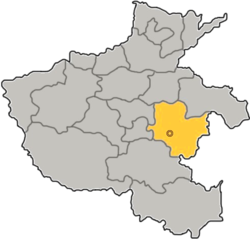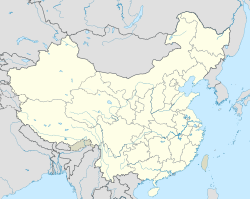Zhoukou
Zhoukou
周口市 Chowkow | |
|---|---|
 Shaying River near downtown of Zhoukou City | |
 Zhoukou in Henan | |
| Coordinates (Zhoukou municipal government): 33°38′12″N 114°42′05″E / 33.6367°N 114.7014°E | |
| Country | People's Republic of China |
| Province | Henan |
| Area | |
| • Prefecture-level city | 11,959 km2 (4,617 sq mi) |
| • Urban | 141 km2 (54 sq mi) |
| • Metro | 1,454 km2 (561 sq mi) |
| Population (2020 census for total, 2018 otherwise)[2] | |
| • Prefecture-level city | 9,026,015 |
| • Density | 750/km2 (2,000/sq mi) |
| • Urban | 721,300 |
| • Urban density | 5,100/km2 (13,000/sq mi) |
| • Metro | 1,601,300 |
| • Metro density | 1,100/km2 (2,900/sq mi) |
| GDP[3][4] | |
| • Prefecture-level city | CN¥ 226.4 billion US$ 34.1 billion |
| • Per capita | CN¥ 25,682 US$ 3,866 |
| Time zone | UTC+8 (China Standard) |
| Postal code | 466000 |
| Area code | 0394 |
| ISO 3166 code | CN-HA-16 |
| Vehicle registration | 豫P |
| Major Nationalities | Han |
| County-level divisions | 9 |
| Township-level divisions | 1 |
| Website | www |




Zhoukou (Chinese: 周口; pinyin: Zhōukǒu; Wade–Giles: Chou-k’ou; postal: Chowkow) is a prefecture-level city in eastern Henan province, China. It borders Zhumadian to the southwest, Xuchang and Luohe to the west, Kaifeng to the northwest, Shangqiu to the northeast, and the province of Anhui on all other sides. As of the 2020 census,[5] its population was 9,026,015 inhabitants. However, as of the 2018 estimation, 1,601,300 lived in the built-up (or metro) made up of Chuanhui district and the northern part of Shangshui county.[2]
The rich history and geographical advantages of Zhoukou have made it a unique city. As the ancient capitals of Emperor Yao and the birthplace of Laozi, it carries a profound cultural heritage of China. At the same time, the remnants of the Chen and Chu cultures endow Zhoukou with a distinctive historical charm. The development of the Lin'gang New City showcases the city's modernization process and economic vitality.[peacock prose]
The convergence of the Sha Ying rivers has endowed Zhoukou with unparalleled geographical advantages, making it a hub known as the Central Plains Port City.[6] This bestowed upon Zhoukou significant importance in ancient times, and today, with further improvements in transportation infrastructure, its advantages are even more pronounced.
The integrated transportation network comprising highways, railways, and waterways has provided robust support for the city's development, facilitating economic growth and connections with the outside world. This transportation advantage has not only driven the local economy of Zhoukou but has also positioned it as a vital nexus linking the Central Plains with other regions.[7]
Administration
[edit]The prefecture-level city of Zhoukou administers 2 districts, 1 county-level city and 7 counties.
- Chuanhui District (川汇区)
- Huaiyang District (淮阳区)
- Xiangcheng City (项城市)
- Shenqiu County (沈丘县)
- Dancheng County (郸城县)
- Luyi County (鹿邑县)
- Taikang County (太康县)
- Fugou County (扶沟县)
- Xihua County (西华县)
- Shangshui County (商水县)
| Map |
|---|
Climate
[edit]| Climate data for Zhoukou (Chuanhui District, 1991–2020 normals, extremes 1981–2010) | |||||||||||||
|---|---|---|---|---|---|---|---|---|---|---|---|---|---|
| Month | Jan | Feb | Mar | Apr | May | Jun | Jul | Aug | Sep | Oct | Nov | Dec | Year |
| Record high °C (°F) | 19.5 (67.1) |
25.7 (78.3) |
28.9 (84.0) |
33.9 (93.0) |
38.5 (101.3) |
40.5 (104.9) |
40.5 (104.9) |
39.8 (103.6) |
37.8 (100.0) |
35.2 (95.4) |
28.0 (82.4) |
21.3 (70.3) |
40.5 (104.9) |
| Mean daily maximum °C (°F) | 6.5 (43.7) |
10.3 (50.5) |
15.8 (60.4) |
22.3 (72.1) |
27.7 (81.9) |
32.2 (90.0) |
32.8 (91.0) |
31.4 (88.5) |
27.8 (82.0) |
22.7 (72.9) |
15.1 (59.2) |
8.6 (47.5) |
21.1 (70.0) |
| Daily mean °C (°F) | 1.8 (35.2) |
5.1 (41.2) |
10.3 (50.5) |
16.5 (61.7) |
22.0 (71.6) |
26.5 (79.7) |
28.1 (82.6) |
26.9 (80.4) |
22.6 (72.7) |
16.9 (62.4) |
9.8 (49.6) |
3.8 (38.8) |
15.9 (60.5) |
| Mean daily minimum °C (°F) | −1.6 (29.1) |
1.2 (34.2) |
5.9 (42.6) |
11.6 (52.9) |
17.0 (62.6) |
20.3 (68.5) |
24.4 (75.9) |
23.5 (74.3) |
18.7 (65.7) |
12.7 (54.9) |
6.0 (42.8) |
0.3 (32.5) |
11.7 (53.0) |
| Record low °C (°F) | −14.4 (6.1) |
−13.9 (7.0) |
−6.6 (20.1) |
−0.4 (31.3) |
5.3 (41.5) |
11.5 (52.7) |
17.4 (63.3) |
13.4 (56.1) |
8.0 (46.4) |
−1.3 (29.7) |
−6.9 (19.6) |
−14.3 (6.3) |
−14.4 (6.1) |
| Average precipitation mm (inches) | 17.0 (0.67) |
20.1 (0.79) |
34.5 (1.36) |
38.9 (1.53) |
72.8 (2.87) |
104.1 (4.10) |
175.7 (6.92) |
137.4 (5.41) |
75.5 (2.97) |
48.4 (1.91) |
37.9 (1.49) |
16.7 (0.66) |
779 (30.68) |
| Average precipitation days (≥ 0.1 mm) | 5.0 | 5.3 | 6.2 | 6.4 | 8.2 | 8.4 | 11.2 | 10.9 | 8.2 | 6.6 | 6.3 | 4.7 | 87.4 |
| Average snowy days | 4.0 | 2.9 | 1.2 | 0 | 0 | 0 | 0 | 0 | 0 | 0 | 0.9 | 2.1 | 11.1 |
| Average relative humidity (%) | 65 | 64 | 63 | 65 | 66 | 66 | 77 | 79 | 74 | 68 | 69 | 65 | 68 |
| Mean monthly sunshine hours | 111.7 | 123.8 | 160.9 | 189.5 | 198.5 | 181.8 | 179.3 | 166.5 | 149.4 | 145.2 | 129.3 | 115.7 | 1,851.6 |
| Percent possible sunshine | 35 | 40 | 43 | 48 | 46 | 42 | 41 | 41 | 41 | 42 | 42 | 38 | 42 |
| Source: China Meteorological Administration[8][9] | |||||||||||||
History
[edit]For thousands of years, Chen (now at Huaiyang) had been the center of this area and a nationally well-known city. The ancient city site founded at Pingliangtai (near Huaiyang) is over 4600 years old, which is one of the oldest cities in China.[10] According to the legend, Fu Xi, the first of the Three Sovereigns of ancient China, died in the city. During the Spring and Autumn period, Chen was the capital of Chen State and then annexed by Chu. Therefore, the area was usually referred to as "Chen Chu" in ancient times. The leaders of the first Chinese peasant uprising (the Dazexiang uprising) established the government at Chen.
The city's name "Zhoukou" is short for "Zhoujiakou", which literally means "Zhou's ferry". Located at the intersection of Jialu River and Shaying River, it started to develop as a river harbor of China's Inland Water Transport System in the early Ming dynasty. By the end of the 18th century, two towns along the rivers merged into one big town with several tens of thousand permanent residents. From the port, cargo could either be shipped south to the Yangtze River or north to the Yellow River. However, after the "sea ban" was canceled, sea transport began to play a major role on the trade between Jiangnan and North China, which diminished the utility of inland waterways. The cost of maintaining the river channels kept increasing because of the ever-rising river bed. The appearance of railways and modern roads in the early 20th century lead to a recession in the water transport business nearby. Finally, in the 1970s, a dam was built on the Shaying River, which cut the city's last waterway.
In 2000, the government of the Zhoukou prefecture-level city was founded. The old county-level city and its suburban area became Chuanhui District.
In 2004, Zhoukou City was recognized as the only prefecture-level "Hometown of Chinese Acrobatics" in the country.[11] On January 22, 2020, the Ministry of Housing and Urban-Rural Development named Zhoukou City a National Garden City. On May 18, 2020, Zhoukou City was awarded the title of "Civilized City of Henan Province". On October 20 of the same year, it was selected as a "National Model City for Supporting Military Service". In 2021, Zhoukou Port was listed as one of the 36 national-level major inland ports.[12] In June 2023, Zhoukou City was granted the title of "Hometown of Chinese Literature" in China.[13]
Economy
[edit]Zhoukou is a major agricultural producer in the province of Henan. Its economy is mainly based on the trade of agricultural products, such as grain, cotton, oil, meat and tobacco. In particular, Zhoukou is famous for the skin of the Huai Goat, a local breed of goat.
Transportation
[edit]Railways
Expressways
- Nanluo Expressway (Nanjing-Luoyang)
- Shangzhou Expressway (Shangqiu-Zhoukou)
- Daguang Expressway (Daqing-Guangzhou)
- Yongdeng Expressway (Yongcheng-Dengfeng)
Highways
- China National Highway 311 (G311)
- China National Highway 106 (G106)
Education
[edit]Universities and Colleges
- Zhoukou Normal University (周口师范学院)
- Zhoukou Vocational College of Science and Technology (周口科技职业学院)
- Zhoukou Institute of Education (周口教育学院)
- Zhoukou Polytechnic (周口职业技术学院)
Schools
- Zhoukou No.7 Middle School (周口七中)
- Huaiyang High School (淮阳中学)
- Zhoukou First High School (周口一高)
- High School of Fugou County (扶沟县高级中学)
- Xiangcheng First High School (项城一高)
- Shangshui First High School (商水一高)
Notable people
[edit]- Laozi (philosopher and central figure in Taoism)
- Wu Guang (leader of the Dazexiang uprising)
- Yuan Shikai (politician)
- Ji Hongchang (general)
- Yue Wenhai (governor)
- Shuping Wang (HIV researcher)
- Wei Rui (sanshou fighter and professional kickboxer)
- Zhang Zhilei (professional heavyweight boxer)
- Jia Aoqi (sanshou fighter and professional kickboxer)
- Xu Jiayin (Chinese businessman and founder of Evergrande Group)
Sister cities
[edit]References
[edit]- ^ 最新人口信息 www.hongheiku.com (in Chinese). hongheiku. Retrieved 12 January 2021.
- ^ a b "China: Hénán (Prefectures, Cities, Districts and Counties) - Population Statistics, Charts and Map". Citypopulation.de. Retrieved 28 November 2021.
- ^ 河南省统计局、国家统计局河南调查总队 (November 2017). 《河南统计年鉴-2017》. 中国统计出版社. ISBN 978-7-5037-8268-8. Archived from the original on 15 November 2018. Retrieved 3 December 2018.
- ^ "河南统计年鉴—2017". www.ha.stats.gov.cn. Archived from the original on 15 November 2018. Retrieved 3 December 2018.
- ^ "Data from the Seventh Population Census of Henan Province". m.gmw.cn. Retrieved 20 March 2023.
- ^ Zhao Hui (11 January 2022). "河南崛起港口"双雄"". Henan Daily. Retrieved 24 April 2024.
- ^ Zhou Jianshan; Fan Qingxu (2002). "Archaeological observation of the history of Zhoukou City". p. 103-105 3 pages in total. Retrieved 24 April 2024.
{{cite web}}: CS1 maint: multiple names: authors list (link) - ^ 中国气象数据网 – WeatherBk Data (in Simplified Chinese). China Meteorological Administration. Retrieved 12 August 2023.
- ^ "Experience Template" 中国气象数据网 (in Simplified Chinese). China Meteorological Administration. Retrieved 12 August 2023.
- ^ 平粮台古城遗址. Archived from the original on 8 July 2011.
- ^ "Zhoukou: Make the cultural business card of "The Hometown of Acrobatics" shine more - Henan Provincial Department of Culture and Tourism". hct.henan.gov.cn. Retrieved 24 April 2024.
- ^ "Tongjiang Dahai - The Rise of the "Shuangxiong" of Henan Inland River Port_Henan News_Henan Provincial People's Government Portal". www.henan.gov.cn. Retrieved 24 April 2024.
- ^ ""Mangyuan" magazine joins hands with Zhoukou, the "hometown of literature" to promote the prosperity of literature and art". news.dahebao.cn. Retrieved 24 April 2024.
External links
[edit]- Zhoukou Municipal Bureau of Culture, Radio, Television and Tourism (Chinese Language Home Page)
- Chuanhui District Government(Chinese Language Home Page)
- Government website of Zhoukou (in Simplified Chinese)


